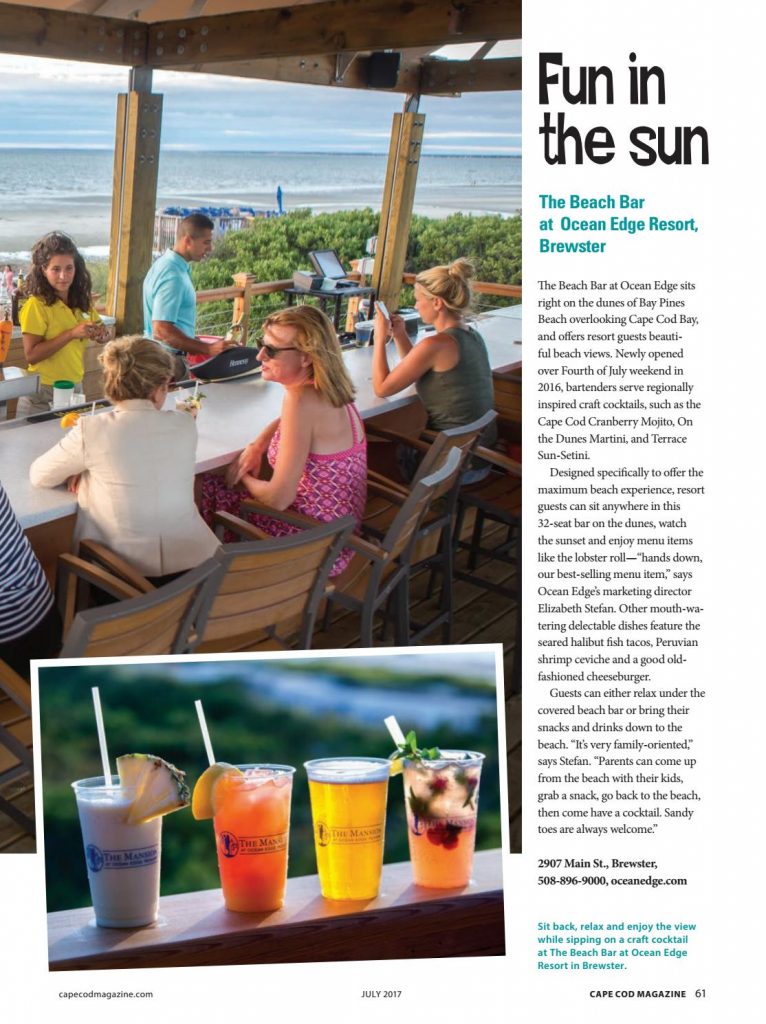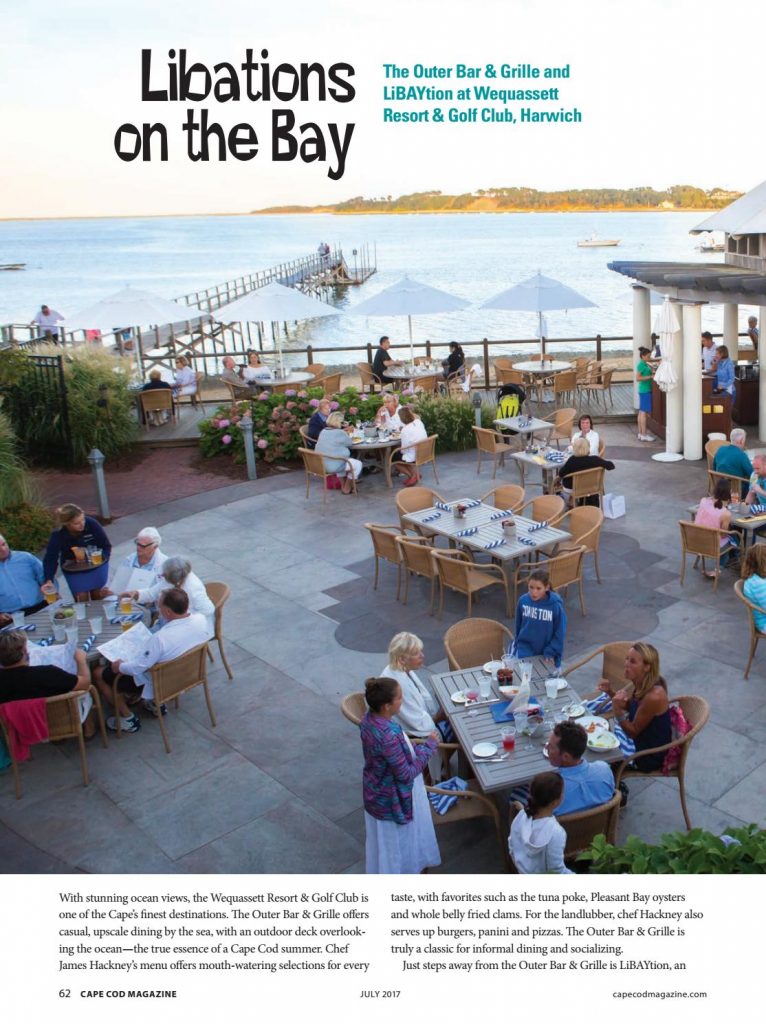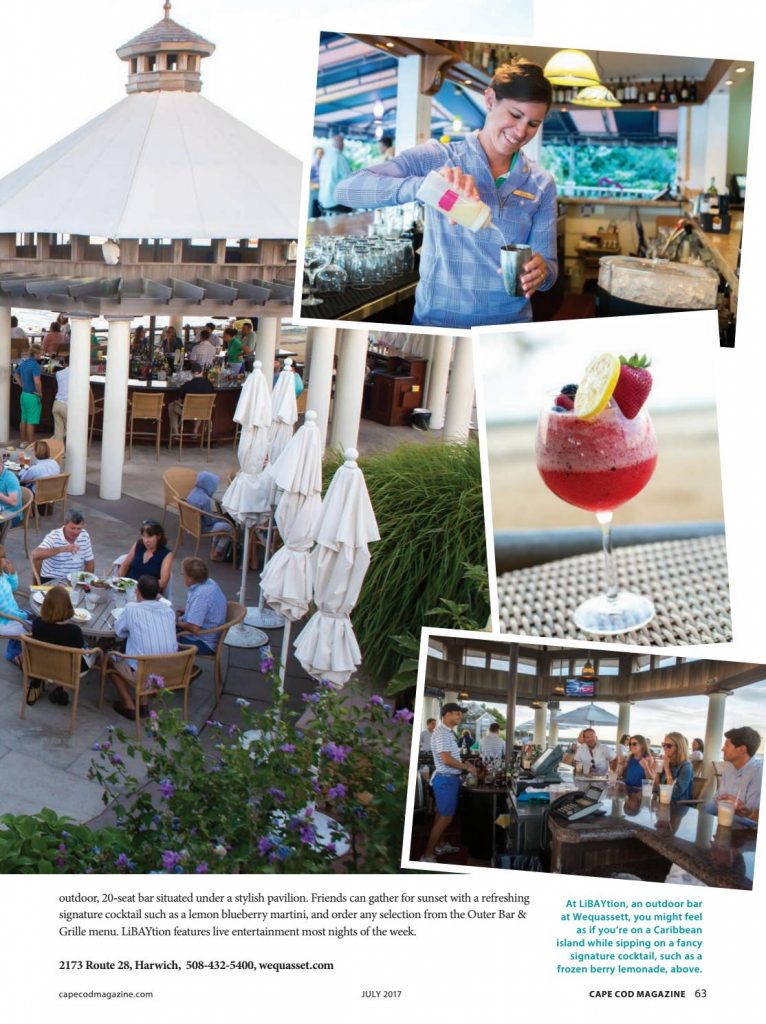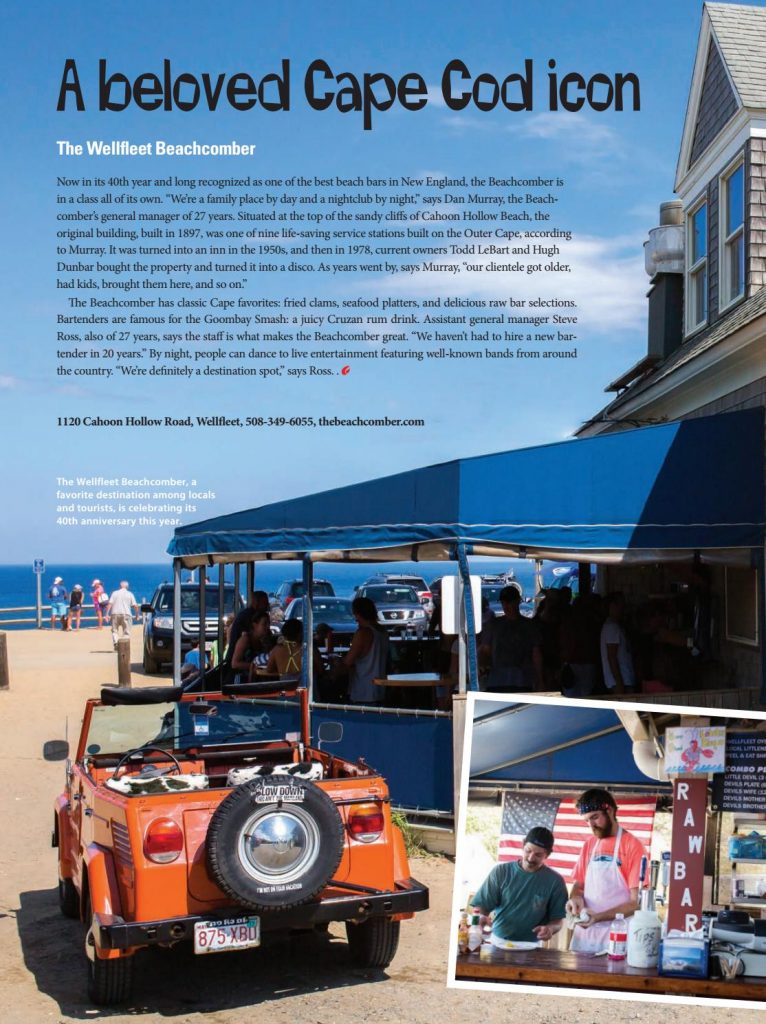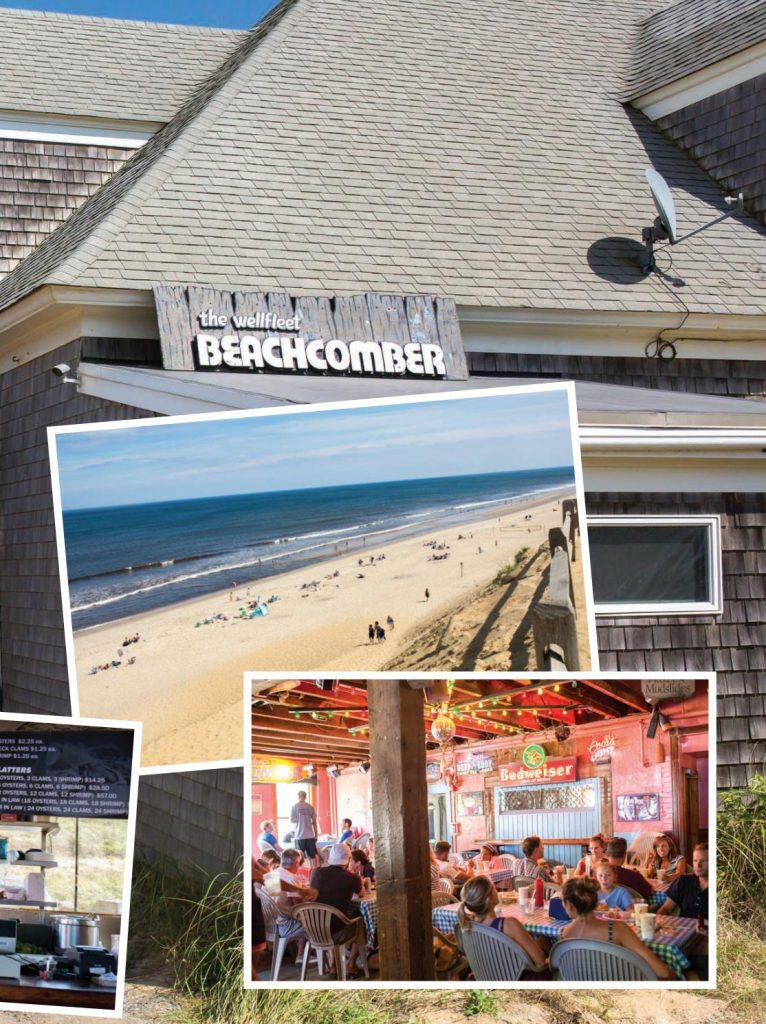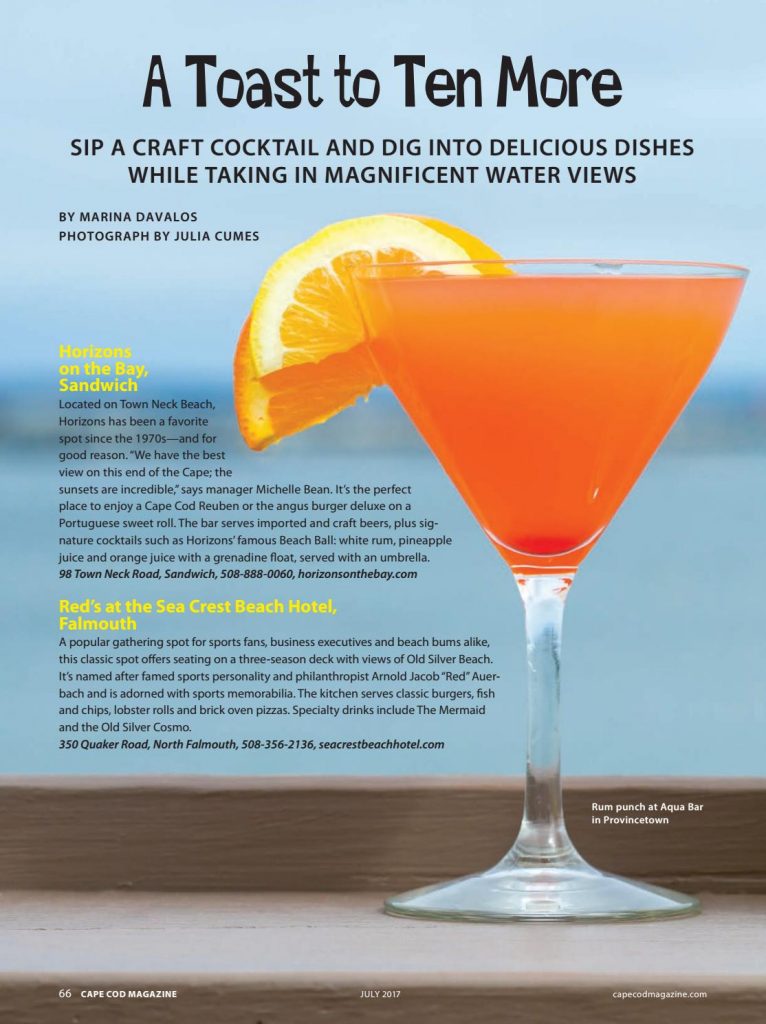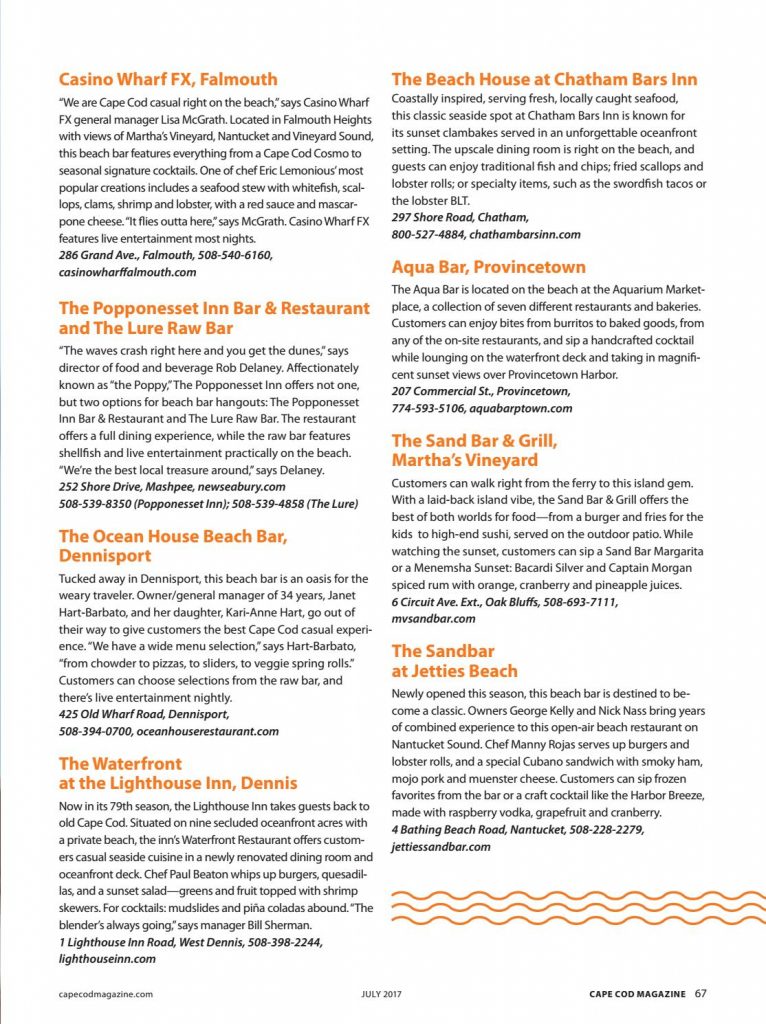In-room wellness offerings are a booming opportunity for hoteliers. The rapidly emerging wellness sector grew 6.5 per cent annually from 2015 to 2017 globally — more than double the growth rate for tourism in general — according to the Florida-based Global Wellness Institute’s (GWI) Global Wellness Tourism Economy Executive Summary, published in November 2018. According to the report, in 2017 travellers spent $639 billion globally on wellness travel — defined by GWI as travel associated with the pursuit of maintaining or enhancing one’s personal wellbeing. READ MORE: http://www.hoteliermagazine.com/hotels-are-differentiating-through-in-room-wellness-offerings/
A local shares her top picks for the Cape Cod restaurants you don’t want to miss.
When traveling, the best restaurant recommendations can often be gleaned from the locals. So when it comes to the top Cape Cod restaurants, you can take my word for it: I’m from the seaside village of Cotuit.
From casual fried seafood at Arnold’s in Eastham to upscale dining at the Naked Oyster in Hyannis – plus a couple of newer additions well on their way to making their mark – if it’s a good meal you’re after, these are the Cape Cod institutions that can’t be missed.
ABBA, Orleans
In an intimate cottage setting, this AAA Three Diamond Rated Cape Cod restaurant introduces a unique blend of Thai, Israeli and Mediterranean-inspired cuisines to local ingredients with tantalizing results. Menu standouts include poached lobster in a curry sauce and Thai seafood stew. Featuring an elegant yet relaxed vibe, ABBA is frequently touted as a place for special occasions.
Arnold’s Lobster & Clam Bar, Eastham
For over 40 years, this has been a go-to spot for the classic Cape seafood experience: fried clams, lobster rolls and ice cream in a family-friendly, casual atmosphere. An 18-hole mini-golf course is a perfect addition. The restaurant is located near the Cape Cod Rail Trailbike path and National Seashore.
Blackfish, Truro
The site of a former blacksmith shop, Blackfish cooks up New American cuisine in a low-key, rustic setting. Locals and tourists alike flock here for unique menu items and a lively bar scene. Panko-crusted sole and seared longfin tuna are examples of menu selections, which change daily. For dessert, try the cinnamon sugar beignets.
Brax Landing, Harwich Port
An institution for generations, this Cape Cod restaurant’s location right on picturesque Saquatucket Harbor makes it even more appealing. Sit out on the harborfront deck and enjoy classics such as steamed lobster, broiled scallops or baked stuffed shrimp. The fried clams, scallops, or fish and chips are done right. Non-seafood lovers can choose from a variety of burgers, including a veggie option.
The Brewster Fish House, Brewster
Set inside an old cottage with an inviting atmosphere, The Brewster has long been a Lower Cape staple. First-course items at this AAA Three Diamond Rated establishment include famous lobster bisque and dayboat scallop sashimi. Main courses include paella of locally sourced mussels, prawns and fluke or poached lobster. Duck or sirloin are excellent seafood alternatives.
Captain Parker’s Pub, West Yarmouth
On scenic Parker’s River, Captain Parker’s is a must-visit, especially if you love clam chowder – the chowder here has won countless awards. Here you’ll find a casual atmosphere and an extensive menu featuring house specials like shrimp scampi and surf and turf.
Ceraldi, Wellfleet
The farm-to-table, seven-course prix fixe menu here changes nightly depending on what’s available from local farmers, fishermen and foragers. Always starting with local oysters, the menu could feature striped bass or skate, Provincetown lobster ravioli or dessert made with local lavender or rhubarb. The menu includes wine, beer or soft flight pairings.
Ciro & Sal’s, Provincetown
This institution, serving traditional northern Italian cuisine, is located downstairs in an old brick wine cellar, its wooden beams adorned with Chianti bottles. A place where artists and fishermen mingle, it’s famous for its pasta dishes including fettucine alla romano, seafood fra diavlo and calamari piccanti.
Fishermen’s View, Sandwich
One of the latest Cape Cod restaurants to hit the scene, the newly constructed Fishermen’s View sits on the Cape Cod Canal and boasts a waterfront view and an upscale vibe. For starters, try the steamers, sliders or raw bar. Then choose from an extensive menu of seafood and land lover specialties.
Mac’s Shack, Wellfleet
You can’t miss this place – set in a 19th century house, the rooftop is adorned with an effigy of a huge fisherman hauling in a gigantic lobster. Mac’s serves classic clam shack fare such as fried clams and fish and chips, plus raw bar selections, sushi and ceviche.
The Mews Restaurant & Cafe, Provincetown
Here, two levels offer two options – go upstairs for a relaxed, cafe vibe, or try downstairs for upscale dining. Menu favorites at this AAA Three Diamond Rated restaurant include the pan-seared sole, shellfish fettuccine and filet mignon. Sip a cucumber lemon drop martini at the bar, which is known for its huge martini list.
The Naked Oyster Bistro & Raw Bar, Hyannis
This upscale setting features brick walls with local artwork for a modern vibe – a perfect place for a naked cantaloupe martini or a barrel-aged Manhattan. The restaurant serves classic raw bar specialties as well as dishes with a worldly flair, like harissa mahi mahi, romesco scallops and Caribbean tuna.
Ocean House Restaurant, Dennis Port
Situated along Nantucket Sound with panoramic views, the Ocean House Restaurant offers dine-in casual elegance for lunch or dinner. The kitchen serves up local favorites such as Cape Cod beer-steamed mussels or New England lobster ravioli. Try the cedar-roasted black cod for a nontraditional take on a classic fish dish. Or try a porterhouse for two.
Old Yarmouth Inn, Yarmouth Port
Consistently recognized as one of the best Cape Cod restaurants for fine dining, the Old Yarmouth Inn exudes a cozy, welcoming ambiance, with a roaring fireplace in the winter. Menu selections include bacon-wrapped filet mignon, orange lavender sole or roasted duck. The inn itself, established in 1696, has a colorful history.
Rock Harbor Grill, Orleans
Central to the overall experience here is the wood-fired pizza, which comes in an array of options, ranging from traditional cheese to specialties like the stark crimson pear or the lamb merguez sausage pizza. The menu also boasts fried seafood favorites plus items like Korean barbecue beef short ribs and a Portuguese chouriço sub.
Part of the appeal of boutique hotels is that they provide guests with an experience far-removed from that of cookie cutter. Though diverse in style and geographic locations, some common threads emerge to shine a light on what makes boutique hotels appealing to guests.
Upscale boutique hotels have traditionally attracted older, more-affluent travellers, but millennials are keen to spend money on experiences and have also been drawn to the segment … READ MORE
Hotelier Magazine, January 24, 2019

Lobbies and other hotel public spaces have become more than their generic counterparts of decades past, often with spaces deliberately designed for guests to be able to hang out and work on their devices. Today’s trends revolve around technology and mobility, says Matt Davis, founding partner of DesignAgency, designers of Toronto’s Broadview Hotel. “It’s also about community, creating socially engaging spaces,” he adds.
Hotelier highlights how trends in the design of hotel public spaces are being implemented across the country — from historic properties to the latest new builds.
THE WALPER HOTEL, KITCHENER, ONT.
The Walper Hotel, built in 1893, completed a full renovation in 2016, updated with an aesthetically pleasing, ultra-modern flair.
Bennett Lo, principal at Dialogue 38 — one of the design firms that worked on the project — points out just a couple of decades ago, when people wanted a workspace away from home or the office, they’d go to a library. Now, people gravitate to coffee shops, lounging with laptops and other devices. Lo says, regionally, many new projects are being designed to accommodate tech-savvy, Internet-age clientele, as Kitchener and the surrounding area is home to tech giants such as Blackberry and Google’s new R&D office.
Instead of providing guests with straight-up lobby space, hotel spaces are being designed with a “coffee-shop” feel, with plenty of places to sit and plug in. “The overall trend is people working with technology and they seem to be working in a lot of different spaces,” he says.
The 92-room boutique hotel is outfitted with not just a first-floor lobby, but a second-floor one as well and both are striking, airy white spaces brightened with splashes of colour and modernist, abstract artwork on the walls. Thoughtfully designed lighting highlights elements of the decor and lends an energy to the space — creating an intriguing, inviting atmosphere for guests.
The second-floor lobby features a bar and a variety of seating areas — tables, the bar, couches — offering a range of spaces where guests can sit with their devices. “We wanted to activate the [second-floor] lobby. We kept the similar look and feel of the first-floor lobby, but it has a different function, with separate but interconnected spaces,” says Lo.
JW MARRIOTT ICE DISTRICT, EDMONTON
In the spring of 2019, the brand-new JW Marriott Ice District will open its doors within Canada’s largest mixed-use sports-and-entertainment district. Located on the first 22 floors of a mixed-use project that has become Edmonton’s tallest building, floors 23 to 56 will house high-end residential condos. The front of the building features a glass façade for an entirely modern vibe. The lobby is huge and features a bar and plenty of options for those on the go with their devices.
The project’s coordinating design architect, Michael Sugarman, says trends are changing the way in which business people use lobbies. “There is a general trend toward the expectation of being able to use the space — ‘this-should-work-for-me’ attitude,” he says.
Sugarman also notes table and desk sizes are becoming smaller, the focus being on immediate resources, ripping away from formality and deference. “A meeting in a JW lobby will be face-to-face with a drink — you don’t need a big table, for example,” he says.
The design of hotel public spaces also needs to transition from daytime to nighttime, says Sugarman, and not become an empty space at night. “We’re trying to activate the space,” he says, “The lobby becomes the place to be. We like to think of the lobby at the JW Marriott as the living room of the district.”
THE BROADVIEW HOTEL, TORONTO
Prior to becoming The Broadview Hotel,this historic building in Toronto’s east end went through several incarnations. Built as a retail space in 1891, it was intermittently used as a hotel, but its most well-known stint was as a boarding house and the notorious Jilly’s Strip Club, which closed in 2014. The Romanesque building was in such rough shape, it almost fell down due to structural damage. When Streetcar Developments and Dream Unlimited purchased the property in 2014, they opted to turn the property into a 58-room boutique hotel.
DesignAgency’s Matt Davis wanted the project’s design to reflect the narrative of the building, which is layered with many experiences. “It’s not about appearances alone — it has a story. The design ties back to the narrative,” he says, adding hotels are embracing the older paradigm of guests being in the community at large. “Classically, it used to be this way,” says Davis. “The post office would be in the hotel, for example, and then that all went away. Today, there’s been a resurgence in community.”
In the Broadview Café & Bar, pink neon rods, curved to abstractly resemble the curve of a woman’s face, hang overhead at the horseshoe-shaped bar, harkening back to a more notorious time in the hotel’s history. The bar itself is, by its nature, more socially engaging than a traditional bar. “It puts the mixologist on display. It activates a social experience,” notes Davis.
Among the property’s notable new features is its Rooftop Restaurant — from the street, it’s a modern, giant glass box placed on top of the roof, contrasting with the hotel’s 1800s architecture. From inside, the glass walls give striking 360° views of the city and hanging plants create a greenhouse vibe. Tables are also positioned close
FAIRMONT EMPRESS, VICTORIA
Originally opened in 1908, the elegant Fairmont Empress sits on Victoria’s Inner Harbour and is recognized as one of the world’s most iconic buildings. In 2017, the property underwent a major redesign, featuring a curated art program by Eaton Fine Art.
“When it comes to curating art for a property, what’s important is that it represents the locale, without being too literal,” says Terry Eaton, who co-owns the company along with partner Robert Williams. “In the lobby mezzanine, for example, the artwork mimics the interior design’s elegance with motifs of brocade patterns and floral bouquets,” he notes, adding pieces of art here show paint spilling over the canvas — a dramatic expression meant to mimic the grand staircase spilling out into the lobby.
Several framed pieces in the lobby — a combination of abstract photography and paintings in both warm and cool tones — celebrate the gardens surrounding the property and the manicured landscapes of Victoria. “Golds and greys are reminiscent of a foggy morning,” says Eaton, adding he prefers to curate art that captures a vibe on an abstract level, rather than a literal one.
Eaton Fine Art also curated 10 framed pieces in the fitness area and 21 in the Willow Stream Spa, which reflect the harbour the property sits on.
–Marina Davalos
For Japanese cuisine on the Cape, Inaho has flourished — even at a time when no one had heard of sushi
Cape Cod Magazine, October 2017
At least twice a week, Inaho’s owner/chef Yuji Watanabe makes an early morning trip to Boston’s fish markets—where he shops for the freshest local seafood. He’ll purchase a whole salmon, tuna or whitefish to serve in the restaurant that night. “He’s a fanatic about freshness,” says his wife, Alda Watanabe. “If it’s not in season, it just doesn’t taste right.”
The Watanabes opened Inaho on April 28, 1989, originally on Main Street in Hyannis. Alda says that while sushi was embraced by some, it was a difficult start. “People were like, ‘Raw fish? No thank you,’” laughs Alda. She says that when they moved their restaurant to Yarmouth Port in 1992, people would say, “You’re crazy, opening a Japanese restaurant in little Yarmouth Port!”

The Watanabes met in 1988 in Newport, Rhode Island, where Yuji was a sushi chef. “I’d gone out for sushi and he was the one who made my food,” Alda says fondly. Before then, Yuji had been a sushi chef in New York City for more than 10 years. Originally from Miyagi Prefecture, about 100 miles north of Tokyo, Yuji has done his share of traveling, including, in his 20s, bicycling around Australia for a year. After he and Alda met, they decided to quit their jobs—his as a sushi chef in Newport, hers at a car dealership—move to Cape Cod and open a Japanese restaurant. Alda says it took a couple of years to build a clientele. But little by little, people would try sushi.

Today, Inaho flourishes, with a waiting list for a table nearly every night. It’s been a family affair. The Watanabes have two sons—Hayato, now 26 and studying to be a lawyer at the University of Michigan; and Hiroto, 20, a pre-med student at Tufts University. They grew up with Inaho. “For them, there was school and a lot of Inaho time.” It was tough work, Alda says. “Sometimes we’d work six days a week throughout the year. We’d be lucky to squeeze in the beach for 15 minutes.”
According to Alda, one of the most popular dinner items, is scallops and lemon. A whole lemon or lime is hollowed out and cut in half. Scallops are mixed in spicy mayo sauce with roe and placed inside the hollowed-out lemon cup. For appetizers, customers love the eggplant with sweet, hot miso on top. “It bubbles up and it’s served piping hot,” says Alda, adding that traditionally Japanese cuisine is ordered for the table, like ordering a bunch of appetizers and sharing. “We bring it out as it’s made, so it’s not just sitting around.”
Popular sushi rolls are the dragon rolls—orange, red or double dragon. The Sophia roll has a seafood mix topped with sliced maguro and crispy fried onions with a spicy garlic ponzu sauce. Another customer favorite is shrimp and veggie tempura. The word Inaho means “ear of rice.” Alda explains: “Each kernel, as it bends over, and it’s heavy, means a good harvest, abundance. If there’s no rice in the house, you can’t do anything.”

–Marina Davalos








